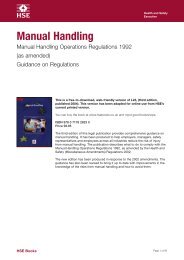Sustainable Transport and the Environment Guide - Unite the Union
Sustainable Transport and the Environment Guide - Unite the Union
Sustainable Transport and the Environment Guide - Unite the Union
Create successful ePaper yourself
Turn your PDF publications into a flip-book with our unique Google optimized e-Paper software.
Appendix 2<br />
(i) Assumptions about <strong>the</strong> utilisation of vehicle capacity: Many estimates of CO 2<br />
emissions from freight transport are based on st<strong>and</strong>ard mode-specific ratios of grams<br />
of CO 2 per tonne-km. In deriving <strong>the</strong>se ratios, researchers often make assumptions<br />
about <strong>the</strong> utilisation of vehicle capacity. The amount of fuel consumed, <strong>and</strong> hence<br />
CO 2 emitted, is very sensitive to vehicle load factors, particularly in <strong>the</strong> case of road<br />
transport. Agencies promoting particular transport modes as being more ‘green’ have<br />
sometimes based CO 2 calculations for <strong>the</strong>ir mode on high levels of utilisation while<br />
using average load factor data for competing modes.<br />
(ii) Use of parameters derived from international studies: in <strong>the</strong> absence of carbon<br />
intensity data for freight transport operations in a particular country, researchers often<br />
rely on intensity values calculated for o<strong>the</strong>r countries or international averages. This is<br />
risky as <strong>the</strong>re are wide international differences in <strong>the</strong> nature <strong>and</strong> efficiency of freight<br />
transport operations, in <strong>the</strong> primary source of electricity (for rail <strong>and</strong> pipeline) <strong>and</strong> in<br />
<strong>the</strong> condition of transport infrastructure.<br />
(iii) National ‘emissions accounting’ typically quantifies CO 2 emissions by industry<br />
sector. Freight transport is an activity which is highly diffuse within an economy,<br />
often undertaken on an ancillary basis by companies whose main activity is not<br />
transport. This makes it difficult to obtain a comprehensive, crosssectoral measure of<br />
CO 2 emissions from freight transport.<br />
(iv) Use of tonne-kms as <strong>the</strong> output measure for freight transport: Analyses of <strong>the</strong><br />
carbon intensity of freight transport invariably express CO 2 emissions as a ratio of<br />
tonne-kms, i.e. weight transported multiplied by <strong>the</strong> distance travelled. For some<br />
modes <strong>and</strong> commodity types it would be more appropriate to measure freight<br />
movement in terms of volume ra<strong>the</strong>r than weight. Lack of government statistics on <strong>the</strong><br />
cubic volume of freight makes this impossible, however.<br />
(v) Movement of freight in passenger vehicles: A significant amount of freight<br />
(mainly shopping) is moved in cars or public transport vehicles. This does not appear<br />
in any official statistics <strong>and</strong> so has not been included in CO 2 calculations for freight<br />
transport. With <strong>the</strong> growth of online shopping, responsibility for <strong>the</strong> ‘last mile’<br />
delivery to <strong>the</strong> home is transferring from <strong>the</strong> consumer to <strong>the</strong> retailer <strong>and</strong> or <strong>the</strong><br />
delivery company. The movement of online retail purchases in vans increases its<br />
statistical visibility. Associated CO 2 emissions are <strong>the</strong>n included in environmental<br />
audits for <strong>the</strong> freight transport sector. The integration of passenger <strong>and</strong> freight<br />
movement in <strong>the</strong> same vehicles also complicates CO 2 auditing in <strong>the</strong> aviation sector.<br />
A large proportion of air cargo moves in <strong>the</strong> bellyholds of passenger aircraft, making<br />
it difficult to decide how much of a plane’s CO 2 emissions should be attributed to <strong>the</strong><br />
airfreight.<br />
(vi) CO 2 <strong>and</strong> o<strong>the</strong>r global warming gases: CO 2 is only one of several gases which<br />
contribute to global warming. It is estimated to account for around 84% of <strong>the</strong> global<br />
warming impact of <strong>the</strong> transport sector in <strong>the</strong> UK. This report is solely concerned with<br />
CO 2 emissions from freight transport operations <strong>and</strong> ignores emissions of o<strong>the</strong>r global<br />
warming gases, such as methane <strong>and</strong> nitrous oxide.<br />
95
















